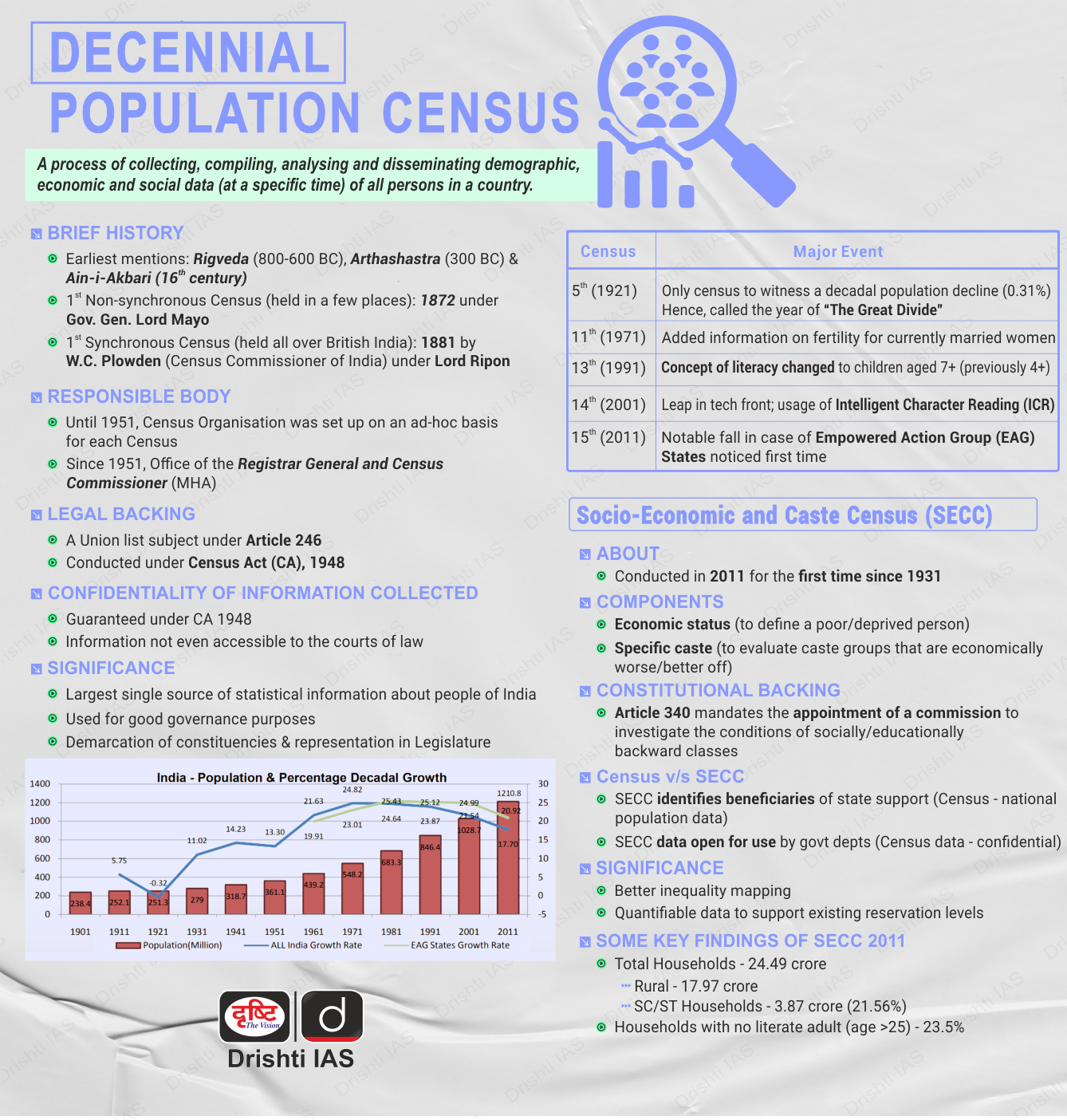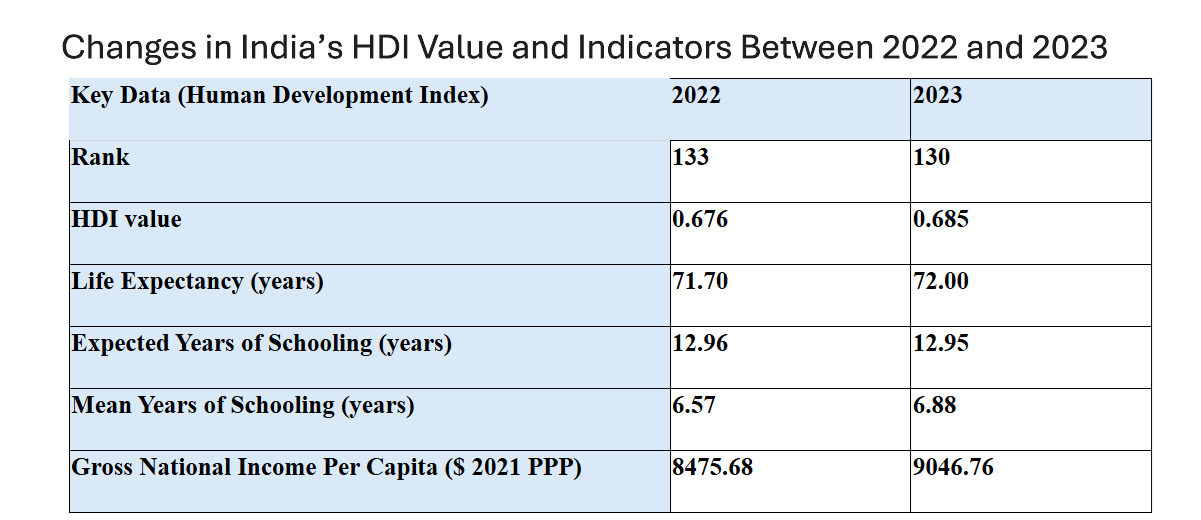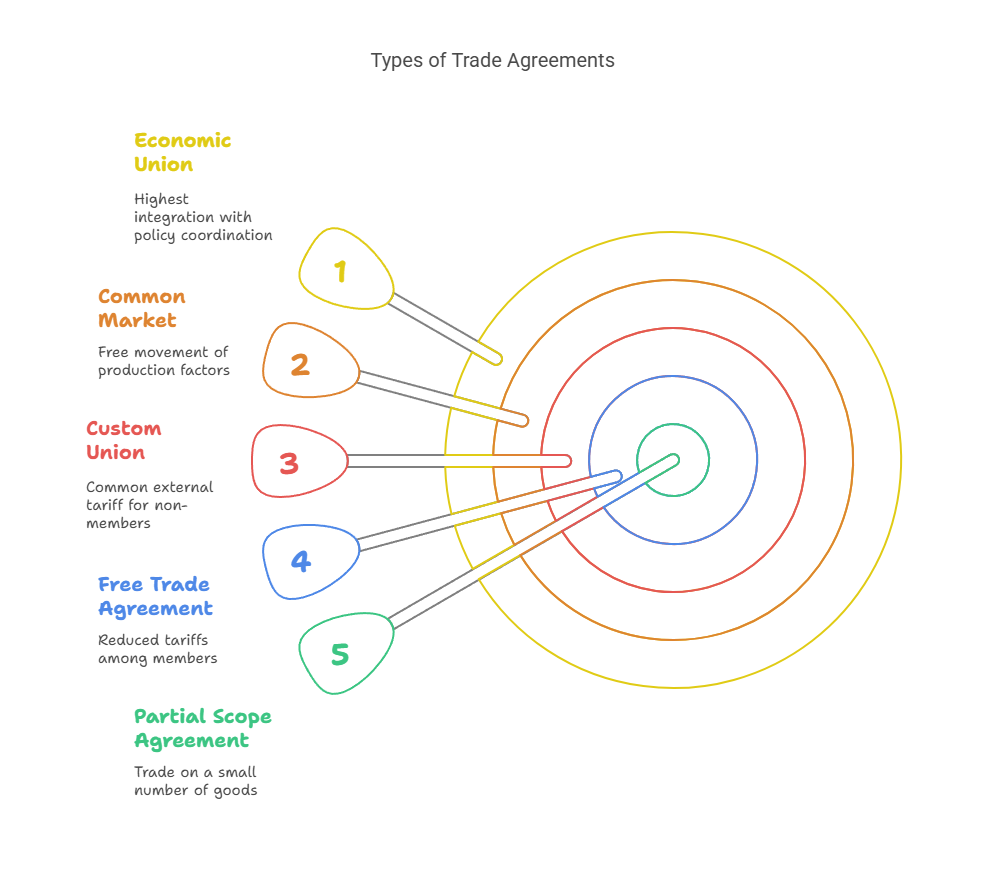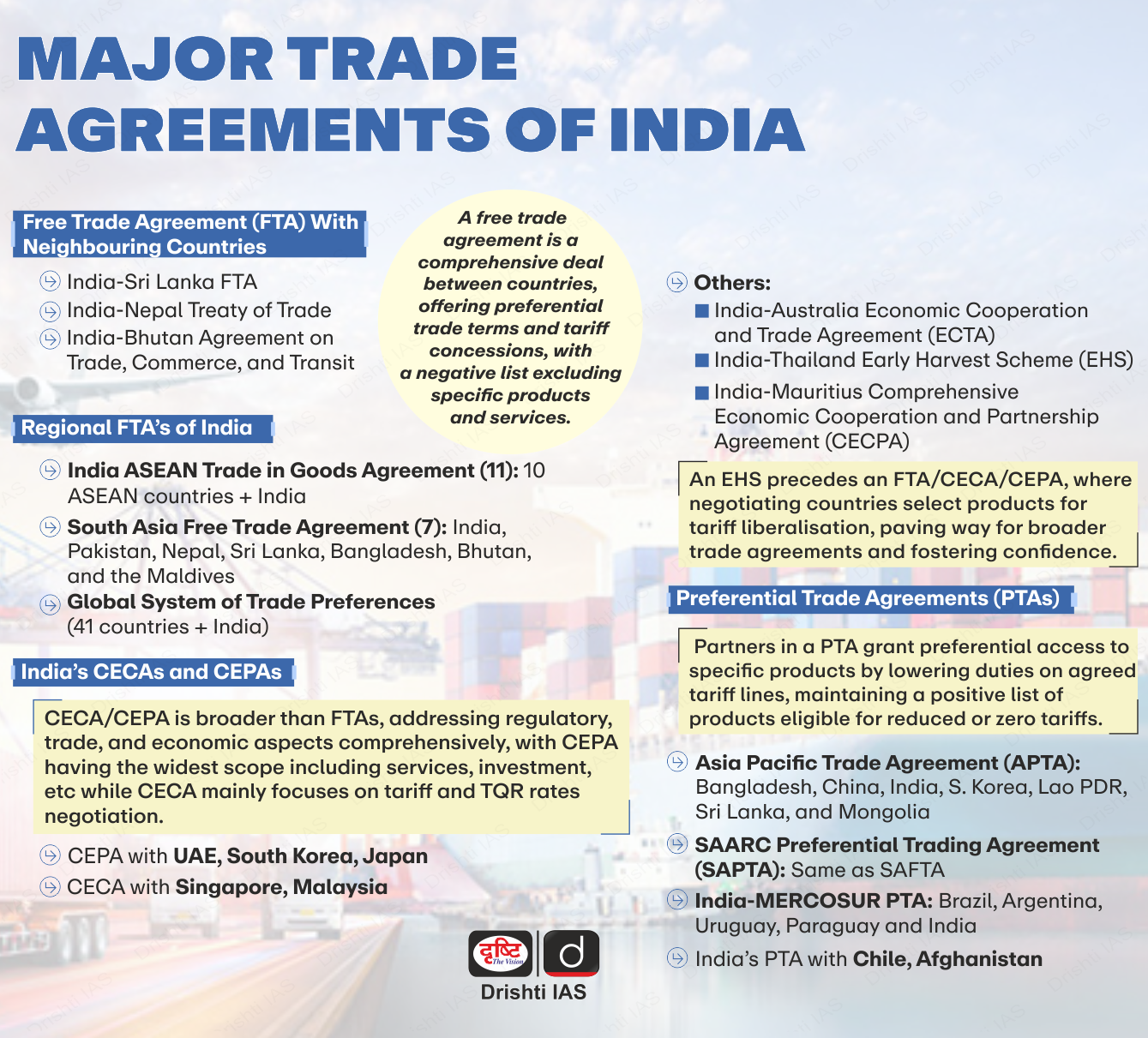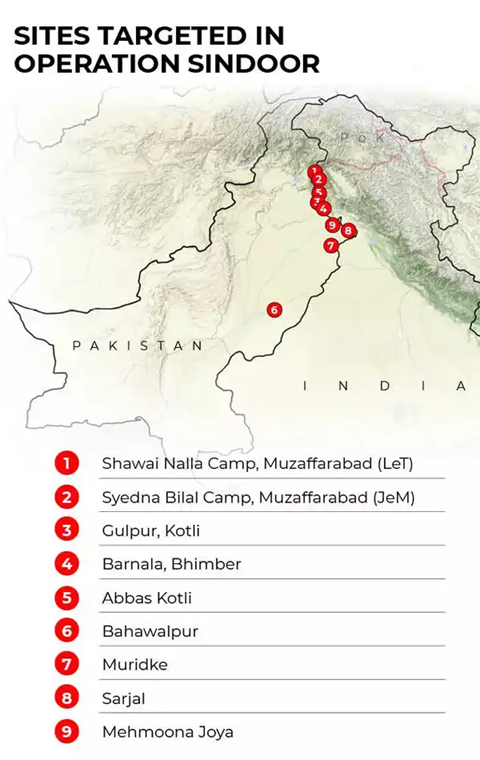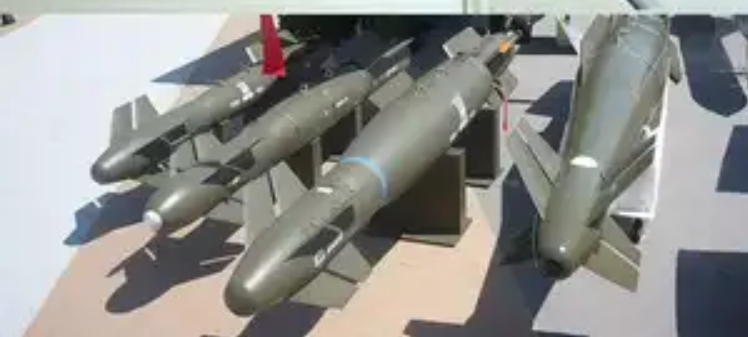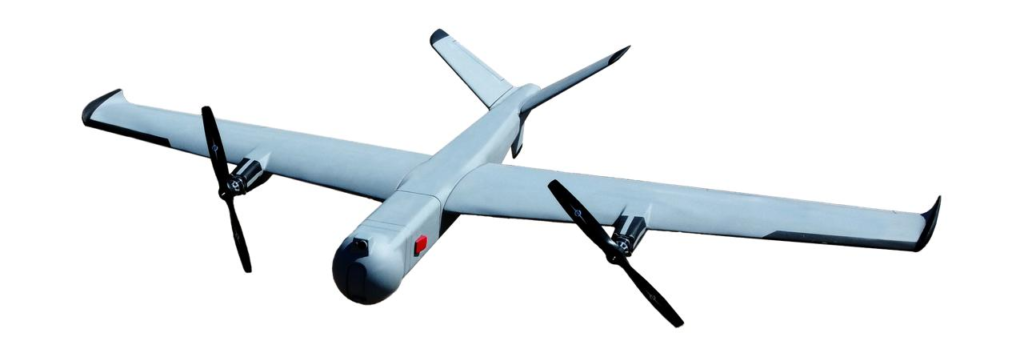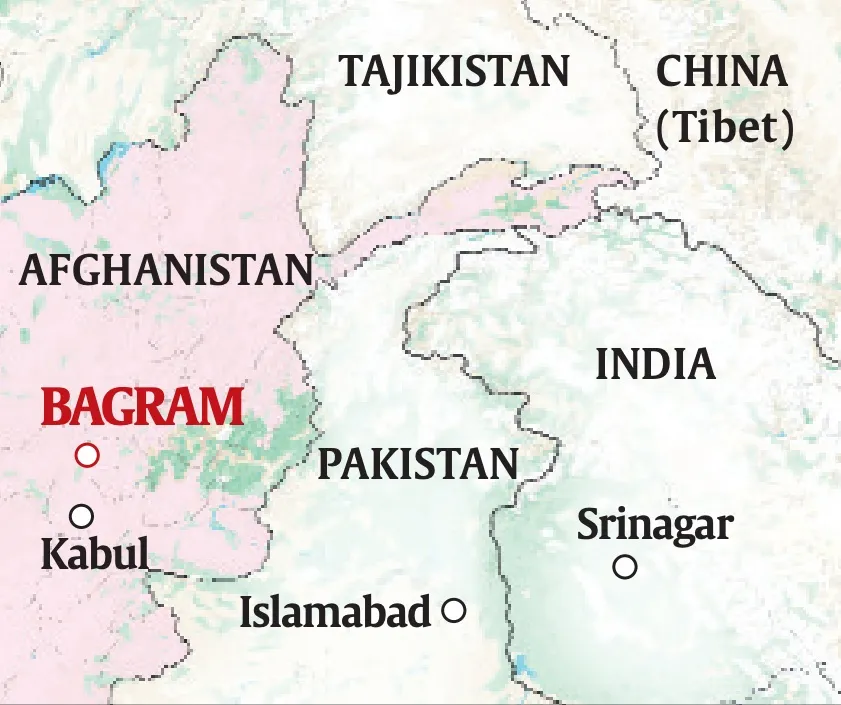Governance
Caste Census in India: Need and Challenges
For Prelims: National Commission for Backward Classes, Caste enumeration, Census, Scheduled Castes, Article 340
For Mains: Role of caste data in shaping affirmative action policies in India, Caste-based census
Why in News?
The Indian government has approved the inclusion of caste enumeration in the delayed Census 2021, reviving a practice discontinued after independence. Triggered by growing political and social demands, this move is expected to significantly impact governance, affirmative action, and social justice efforts.
What is a Caste Census?
- Definition: A caste census is a systematic collection of data on individuals’ caste identities during a nationwide population census.
- The word "caste" comes from the Spanish word 'casta', meaning 'race' or 'hereditary group'. The Portuguese used it to denote ‘Jati’ in India.
- M. N. Srinivas (Indian sociologist) defines caste as a hereditary, endogamous, and usually localized group, linked to a specific occupation, and occupying a certain position in the social hierarchy.
- Objective: It aims to understand the socio-economic distribution of various caste groups to inform policies on social justice, reservations, and welfare.
- Historical Context of Caste Enumeration: Caste enumeration was a regular feature of census exercises during British rule from 1881 to 1931, while the 1941 Census also collected caste information but did not publish it due to the onset of World War II.
- Since the 1951 Census, caste enumeration was discontinued for all except Scheduled Castes (SCs) and Scheduled Tribes (STs), leaving no reliable national data on Other Backward Classes (OBCs) and other caste groups.
- In 1961, the central government allowed states to conduct surveys and compile state-specific lists of OBCs.
- The last national caste data collection was in 2011 through the Socio-Economic and Caste Census (SECC), aimed at assessing households' socio-economic conditions along with caste information.
- State-level Surveys: States like Bihar, Karnataka, and Telangana recently conducted their own caste surveys.
What is the Difference Between Caste Census and Caste Survey?Click Here to Read More: Caste Survey and Caste Census |
What is the Need for a Caste Census?
- Current Gap: While data exists for SCs and STs, there is no reliable, updated national data on OBCs and other caste groups, hindering effective policy formulation.
- Addressing Challenges from Previous Surveys: The 2011 SECC had significant flaws, particularly the lack of a comprehensive caste list.
- The National Commission for Backward Classes (NCBC), pointed out, the 2011 SECC proforma allowed citizens to enter any caste, leading to an overwhelming and inaccurate number of caste entries.
- This rendered the data unreliable and impractical. The upcoming caste census aims to address these issues by ensuring a more accurate and inclusive process.
- Reshaping Affirmative Action: The caste census can provide updated data to reassess reservation quotas and affirmative action programs.
- The absence of caste data has left OBC population estimates unclear; the last available data from the 1931 Census showed OBCs at 52%, which influenced the Mandal Commission’s 1980 reservation recommendations.
- Bihar's 2023 caste survey found OBCs and EBCs make up over 63% of the state's population, fueling calls for national-level caste data to guide policy decisions on reservations and social welfare.
- Sub-Categorization Within Broad Groups: Detailed data enables the sub-categorization of OBCs, as recommended by the Rohini Commission (2017), to ensure equitable distribution of reservation benefits.
- Political and Electoral Implications: Accurate caste data can lead to better political representation of marginalized groups, especially in state and national elections.
- Push for Equality and Inclusivity: Caste-based inequalities intersect with poverty, region, and gender.
- A caste census can highlight these disparities, aiding targeted policies. It is seen as a step toward addressing entrenched inequalities and creating more inclusive, equitable policies for diverse communities.
What are the Concerns Regarding a Caste Census in India?
- Risk of Reinforcing Caste Identities: Critics argue that a caste Census could entrench caste consciousness, legitimizing divisions rather than working toward a caste-less society.
- May deepen social segmentation and hierarchies, contradicting the constitutional goal of promoting fraternity and equality.
- Equity vs. Equality: While larger groups may benefit from representation, micro-quota fragmentation harms social cohesion.
- Disproportionately excludes minorities within the backward classes due to scale bias.
- Hyper-fragmentation risks undermining affirmative action meant for historically oppressed groups.
- Political Exploitation and Competitive Backwardness: Accurate caste data may fuel vote-bank politics, with parties tailoring policies for electoral gain.
- It could trigger demands for OBC/ST/SC status by politically dominant or upper caste groups, increasing pressures on reservation quotas.
- May lead to "competitive backwardness", where groups seek lower status for benefits.
- Constitutional and Legal Ambiguities: Though Article 340 permits the identification of backward classes, there is no constitutional mandate for caste enumeration in the general Census.
- Issues with Proportional Representation: Fresh caste data may challenge policies based on 1931 estimates, triggering demands for proportionate reservations and calls to revise the 51% cap set by the Indra Sawhney judgment, 1992.
- This shift might also encourage larger communities to seek greater benefits, undermining population control programs and affecting their effectiveness.
What are the Challenges in Conducting an Accurate Caste Census?
- Lack of a Standardized Caste List: A key challenge in conducting a caste Census is the lack of a standardized caste code list, no unified OBC list exists, the Central OBC list (used for central schemes) differs from more expansive state-specific lists.
- The SECC 2011’s open-ended self-reporting led to 46.7 lakh caste entries and over 8 crore errors, highlighting the difficulty of classifying India’s thousands of castes and sub-castes in a consistent, reliable manner.
- Caste Self-reporting and Mobility Claims: Individuals may claim affiliation with a higher caste due to its prestige, as seen in the colonial censuses where communities alternated between identifying as Kshatriya, Rajput, Brahmin, or Vaishya.
- In the post-independence period, some individuals may falsely identify with lower castes to gain benefits from reservations (e.g., some upper castes seeking OBC status).
- Caste identities are often fluid, and self-reporting can vary across regions or generations.
- Misclassification of Castes: Confusion Due to similar surnames like ‘Dhanak’, ‘Dhankia’, ‘Dhanuk’, and ‘Dhanka’ belong to different caste categories (SC, ST, etc.), leading to errors.
- Additionally, differing classifications across states further complicate the census, for example, the Meena community is classified as ST in Rajasthan but as OBC in Madhya Pradesh.
- Given the sensitivity of caste in India, enumerators may avoid direct questions and rely on assumptions based on surnames, often leading to inaccurate entries.
- Institutional and Administrative Capacity Constraints: The Census lacks a dedicated verification and coding unit, which may lead to the new caste census data being as unreliable as the SECC 2011 data.
What Measures Can Ensure the Credibility and Accuracy of a Caste Census in India?
- Listing Castes: The first step is to list the castes and communities to be enumerated, considering differing classifications across states. The Registrar General of India and Census Commissioner must consult with academics, caste groups, political parties, and the public to finalize this list.
- Without this, there is a risk of repeating the inconsistencies observed in the 2011 census.
- Data Verification and Grievance Redressal: To improve caste census credibility, integrating Aadhaar can help reduce duplication and ensure accurate identity verification.
- A multi-tier verification mechanism should be established to reduce classification errors, complemented by a transparent grievance redressal system for resolving disputes and misclassifications. Additionally, involving community-level oversight will strengthen local validation and foster public trust in the enumeration process.
- Leverage Artificial Intelligence and Machine Learning for accurate data sorting and analysis.
- Sub-categorization for Equity: Implement Justice Rohini Commission's recommendations for sub-categorizing OBCs.
- Aligning with the Supreme Court judgment in State of Punjab v. Davinder Singh (2024), sub-classify SCs and STs within the reservation quota based on varying levels of backwardness, using empirical data and historical evidence.
- Ensure more equitable distribution of reservation benefits and representation among various sub-groups.
- Socio-Economic Integration: Supplement caste data with indicators like the Multidimensional Poverty Index (MPI).
- The Tendulkar Committee (2009) found that 29% of below poverty line (BPL) cardholders are poor, while 13% of Above Poverty Line (APL) cardholders are poor.
- This calls for revising outdated poverty measures and conducting an effective socio-economic census to address inclusion and exclusion errors.
- Focus on regional disparities; allow states the flexibility to design welfare schemes beyond a ‘one-size-fits-all’ approach.
- The Tendulkar Committee (2009) found that 29% of below poverty line (BPL) cardholders are poor, while 13% of Above Poverty Line (APL) cardholders are poor.
- Ensuring Fair Usage and Avoiding Political Misuse: Treat the caste census as a tool for inclusive development, not vote-bank politics. Use data to rationalize existing policies and target the most disadvantaged.
- Monitor and evaluate policies implemented using census data to ensure intended outcomes.
Conclusion
The caste census marks a pivotal shift in India's data-driven governance, aiming to bridge historical gaps in representation and welfare. While it promises inclusivity and better policy targeting, concerns around accuracy, politicization, and social harmony must be addressed. Robust safeguards and transparent execution, in line with Sustainable Development Goal 16 (enabling data-driven governance), will be key to its success.
|
Drishti Mains Question: A caste census can serve as a powerful tool for social justice, but it also risks reinforcing social divisions. Discuss |
UPSC Civil Services Examination, Previous Year Question
Prelims
Q. Consider the following statements: (2009)
- Between Census 1951 and Census 2001, the density of the population of India has increased more than three times.
- Between Census 1951 and Census 2001, the annual growth rate (exponential) of the population of India has doubled.
Which of the statements given above is/are correct?
(a) 1 only
(b) 2 only
(c) Both 1 and 2
(d) Neither 1 nor 2
Ans: (d)
Exp:
- One of the important indices of population concentration is the density of population. It is defined as the number of persons per square kilometre.
- The population density of India in 2001 was 324 persons per square kilometre and in 1951 it was 117. Thus, the density increased more than twice, but not thrice. Hence, statement 1 is not correct.
- At the beginning of the twentieth century, i.e., in 1901 the density of India was as low as 77 and this steadily increased from one decade to another to reach 324 in 2001.
- The average Annual Growth Rate in 2001 was 1.93 whereas in 1951 it was 1.25. Thus, it increased, but not doubled. Hence, statement 2 is not correct. Therefore, option (d) is the correct answer.
Mains
Q. Why is caste identity in India both fluid and static? (2023)
Q. Has caste lost its relevance in understanding the multi-cultural Indian Society? Elaborate your answer with illustrations. (2020)
Q. “Caste system is assuming new identities and associational forms. Hence, the caste system cannot be eradicated in India.” Comment. (2018)


Indian Polity
Strengthening Parliamentary Oversight in India
For Prelims: Question Hour, Standing Committees, Constituent Assembly, Article 75, No-confidence Motion
For Mains: Parliamentary Oversight in India, Post-Legislative Scrutiny in India, India’s Governance Model
Why in News?
India’s push for ‘Maximum Governance’ must be matched by ‘Maximum Accountability’, prompting renewed focus on strengthening Parliament’s role in checking executive power.
- However, tools like Question Hour and Standing Committees often underperform, making reforms essential for effective democratic oversight and policy implementation.
What are the Key Mechanisms of Parliamentary Oversight?
- Constitutional Foundations: Dr. B.R. Ambedkar advocated for a parliamentary form of government due to its in-built mechanism for daily executive accountability through questions, motions, and debates.
- The Constituent Assembly debated for 167 days to design a system ensuring checks and balances within a democratic framework.
- Constitutional Provisions of Parliamentary Oversight: Article 75 states that the Council of Ministers is collectively accountable to the Lok Sabha, ensuring executive accountability in a Westminster-style democracy.
- Article 108 allows the President to call a joint sitting of both Houses to resolve legislative deadlocks.
- Article 111 grants the President the power to assent, withhold, or return a Bill (except Money Bills) to Parliament for reconsideration. This power serves as a check on legislative actions.
- Article 113 ensures that the government cannot incur any expenditure unless approved by Parliament through an Appropriation Bill.
- Article 114 governs the authorization of expenditure from the Consolidated Fund.
- Parliamentary Oversight Mechanisms:
- Question Hour: MPs (private members) question ministers directly on government actions and policies.
- Zero Hour: The Zero Hour is an Indian parliamentary innovation not found in the parliamentary rule book, it allows MPs to raise urgent matters without prior notice.
- It begins immediately after Question Hour and continues until the day’s official agenda starts.
- Parliamentary Committees: The Parliamentary committees, empowered by Article 105 (Parliamentary privileges) and Article 118 of the Constitution (deals with the rules of procedure for the Houses of Parliament), play a vital role in legislative oversight.
- Standing Committees scrutinize Bills, policies, and administrative actions, while the Public Accounts Committee (PAC) audits government spending.
- The Estimates Committee reviews budget estimates and recommends reforms for efficient resource use.
- No-confidence motions and debates allow Parliament to hold the government accountable.
- Successes of Oversight Mechanisms: The Standing Committee on Railways recommended waiving Indian Railways’ dividend payments in 2015 to improve financial health, which was implemented in 2016.
- The Standing Committee on Transport influenced the 2017 Motor Vehicles Act amendments by removing caps on third-party insurance and creating a National Road Safety Board.
- The Committee on Public Undertakings addressed delays in NHAI projects by recommending work begin only after acquiring 80% of land and clearances.
- The Estimates Committee advocated for new uranium mines to cut import dependence.
- The Public Accounts Committee (PAC) exposed corruption in the 2010 Commonwealth Games and has made an average of 180 recommendations annually over the past eight years, with around 80% accepted by the government, reflecting its significant influence on ensuring financial accountability.
- Judicial Pronouncements: S.R. Bommai v. Union of India, 1994, the Supreme Court (SC) of India reinforced the principle of collective responsibility (Article 75) and emphasized that the executive must have the confidence of the legislature.
- In State of Kerala vs. K. Ajith and Others (2021), the SC held that parliamentary privileges and immunities do not exempt members from adhering to general laws, especially criminal laws that apply to all citizens.
- In Manohar Lal Sharma v. Principal Secretary (2014), the SC ruled that the allocation of coal blocks between 1993 and 2010 was arbitrary and illegal, violating Article 14 of the Constitution.
- The decision was based on findings from the Comptroller and Auditor-General of India and PAC.
What are the Key Gaps in Parliamentary Oversight?
- Erosion of Question Hour's Effectiveness: Question Hour, intended to ensure daily executive accountability, is often disrupted by protests and adjournments.
- In the 17th Lok Sabha (2019–24), it operated only 60% of the time in Lok Sabha and 52% in Rajya Sabha.
- Even when it functions, MPs tend to raise isolated or superficial queries instead of engaging in coordinated scrutiny of complex policies.
- Underutilisation of Parliamentary Committees: Department-related Standing Committees (DRSCs) generate detailed reports, but these are rarely discussed on the House floor.
- Despite robust evaluations, committee findings have limited influence on lawmaking and executive action.
- The temporary and rotating nature of committees inhibits members from developing subject-matter expertise and continuity.
- Lack of Post-Legislative Scrutiny: There is no institutionalised mechanism to evaluate the implementation and impact of laws once they are enacted.
- Without follow-up review, it is unclear whether legislation achieves its intended outcomes.
- Unlike countries such as the UK, India does not mandate periodic departmental reviews of major laws.
- Limited Accessibility and Public Engagement: Committee reports and findings are often not accessible to the general public in user-friendly formats.
- Lack of translations, visual aids, or simplified explanations restricts public awareness and civic engagement with legislative oversight.
- Missed Opportunities in Technology Adoption: Parliament has not adequately leveraged Artificial Intelligence, data analytics, or digital tools to enhance scrutiny.
- Without modern tools, MPs face difficulties in identifying irregularities or patterns in government performance.
What Reforms are Needed to Strengthen Parliamentary Oversight?
- Institutionalise Post-Legislative Scrutiny: Adopting models like the UK, where government departments submit reviews of major laws every three to five years for parliamentary scrutiny, would help ensure laws deliver on their promises.
- Establish sub-committees under DRSCs to review the impact and compliance of laws 3–5 years after enactment.
- Adopt Technology for Smarter Oversight: Use AI tools and data analytics to help MPs examine budget documents, Comptroller and Auditor-General of India (CAG) reports, and ministry performance more effectively.
- Build searchable databases for legislative tracking, budget comparisons, and law implementation status.
- Build MP Capacity: Under PRIDE (Parliamentary Research and Training Institute for Democracies) create a Parliamentary Research Service (PRS)-style institutional unit within Parliament. Offer structured orientation for newly elected MPs and ongoing issue-based briefings.
- Create a Parliamentary Fellows Programme offering each MP access to trained legislative researchers.
- Promote Transparency: Use the Bhashini platform to translate committee reports into regional languages and create multilingual visual explainers.
- Launch public dashboards to track committee recommendations, ministerial responses, and government compliance for greater accountability.
Conclusion
Parliamentary oversight is crucial for democratic accountability. Empowering Parliament with post-legislative review, technology, and support ensures effective law implementation and strengthens executive accountability without weakening it.
|
Drishti Mains Question: Discuss the provisions that ensure parliamentary oversight in India. How can these be strengthened for better governance? |
UPSC Civil Services Examination, Previous Year Questions (PYQ)
Mains
Q. The ‘Powers, Privileges and Immunities of Parliament and its Members’ as envisaged in Article 105 of the Constitution leave room for a large number of un-codified and un-enumerated privileges to continue. Assess the reasons for the absence of legal codification of the ‘parliamentary privileges’. How can this problem be addressed? (2014)


Governance
Human Development Report 2025
For Prelims: Human Development Report, United Nations Development Programme, Artificial Intelligence, National Health Mission, Multidimensional poverty
For Mains: Human Development Index and its implications for India, Role of Artificial Intelligence in addressing human development challenges
Why in News?
India has been ranked 130th out of 193 countries and territories in the 2025 Human Development Report (HDR), titled "A Matter of Choice: People and Possibilities in the Age of AI", released by the United Nations Development Programme (UNDP).
- The report noted that while India has made steady strides, inequality continues to undercut its human development achievements.
What are the Key Highlights of Human Development Report 2025?
Global
- Stalled Human Development Progress: The global HDI saw its smallest increase since 1990 (excluding the 2020-2021 crisis years).
- If pre-Covid trends had continued, most countries could have reached very high human development by 2030, this is now likely to be delayed by decades.
- Top and Bottom Ranks: Iceland ranked first with an HDI of 0.972, while South Sudan ranked last with an HDI of 0.388.
- Growing Inequality: The disparity between the richest and poorest nations has been widening, with high-HDI countries continuing to make progress while low-HDI countries face stagnation.
- AI and Future of Work: The report notes that Artificial Intelligence (AI) is rapidly spreading, with 1 in 5 people globally already using AI tools.
- While 60% served people believe AI will create new job opportunities, half fear it could replace or transform their current roles.
- The 2025 Human Development Report emphasizes the need for inclusive, human-centered AI policies to ensure AI contributes positively to human development, rather than exacerbating inequalities or displacing jobs.
India
- India’s HDI Ranking: India ranked 133rd in 2022 and improved to 130th in 2023, with its HDI value rising from 0.676 to 0.685.
- The country remains in the "medium human development" category, though it is approaching the threshold for "high human development" (HDI ≥ 0.700).
- Regional Comparison: Among India’s neighbors, China (78th), Sri Lanka (89th), and Bhutan (125th) rank above India, while Bangladesh (130th) is on par. Nepal (145th), Myanmar (150th), and Pakistan (168th) are ranked below India.
- Progress in Key Areas:
- Life Expectancy: India’s life expectancy rose from 58.6 years in 1990 to 72 years in 2023, the highest ever, reflecting a strong post-pandemic recovery.
- This progress is attributed to national health programs like National Health Mission, Ayushman Bharat, Janani Suraksha Yojana, and Poshan Abhiyaan.
- Education: India's mean years of schooling have increased, with children now expected to stay in school for 13 years, up from 8.2 years in 1990.
- Initiatives like the Right to Education Act 2009, National Education Policy 2020, and Samagra Shiksha Abhiyan have improved access, though quality and learning outcomes still require attention.
- National Income: India’s Gross National Income per capita rose over fourfold, from USD 2,167 in 1990 to USD 9,046 in 2023 based on 2021 Purchasing Power Parity (PPP).
- Additionally, 135 million Indians escaped multidimensional poverty between 2015-16 and 2019-21, contributing to HDI improvement.
- AI Skills Growth: India is emerging as a global AI leader with the highest self-reported AI skills penetration.
- 20% of Indian AI researchers now remain in the country, a significant rise from nearly zero in 2019.
- Life Expectancy: India’s life expectancy rose from 58.6 years in 1990 to 72 years in 2023, the highest ever, reflecting a strong post-pandemic recovery.
- Challenges Impacting India’s HDI:
- Inequality Reduces HDI: Inequality has reduced India’s HDI by 30.7%, one of the highest losses in the region.
- Gender Disparities: Female labour force participation (at 41.7% and political representation continue to lag.
- Steps like the 106th constitutional amendment reserving one-third of legislative seats for women show promise for transformative change.
How can Artificial Intelligence Contribute to Human Development?
- Enhancing Productivity and Economic Growth: AI is expected to significantly boost productivity, with 70% of global respondents optimistic about its impact. By automating routine tasks, AI allows focus on innovation in sectors like manufacturing, services, and agriculture.
- A Google report estimates AI could add Rs 33.8 lakh crore to India's economy by 2030, playing a key role in reaching the USD 1 trillion digital economy target by 2028 and contributing 20% to GDP.
- Improving Access to Healthcare: In radiology, AI improves accuracy, detecting abnormalities that may be missed by human eyes, while in oncology, it helps create personalized treatment plans based on patient data.
- AI also streamlines clinical workflows, optimizes resource allocation, and supports remote monitoring and telemedicine, particularly in underserved areas.
- Furthermore, AI is revolutionizing medical education with virtual reality (VR) and adaptive learning, enhancing healthcare professionals' skills.
- Transforming Education: AI enables personalized learning through adaptive platforms, with real-time support from AI tutors and chatbots, especially in underserved areas.
- It also helps educators track student progress and identify learning gaps more effectively.
- Empowering Governance: AI is streamlining public service delivery in India by improving efficiency, enhancing transparency, and detecting fraud in welfare schemes.
- Tools like MuleHunter.AI, developed by the Reserve Bank of India, help combat digital fraud involving mule bank accounts.
- The government’s Bhashini project boosts multilingual communication, aiding policy outreach across linguistic groups.
- Addressing Inequality and Promoting Inclusion: AI tools can identify and bridge gaps in service delivery, particularly for marginalized communities. When guided by human-centered design, AI can ensure equitable access to opportunities.
How can India Address its Human Development Challenges?
- Gender Equality: To advance gender equity, India must effectively implement the 106th Constitutional Amendment ensuring one-third reservation for women in legislatures and strengthen their decision-making roles.
- Expanding access to financial schemes like PM Mudra Yojana, Stand-Up India, and digital freelancing platforms can boost women’s entrepreneurship. Increasing female workforce participation requires flexible jobs, skilling, crèche support, and promotion of STEM participation through initiatives like Vigyan Jyoti.
- Legal reforms must include stricter enforcement against gender-based violence, child marriage, and workplace discrimination
- Strengthening the Nirbhaya Fund and One Stop Centres is also essential for comprehensive support to women facing violence.
- Address Inequality: To tackle rising inequality (as reflected in India’s 2023 Gini coefficient of 0.410), the government should strengthen inclusive initiatives such as Mahatma Gandhi National Rural Employment Guarantee Act, Prime Minister's Employment Generation Programme, and Jan Dhan Yojana.
- These programs help address income inequality, but long-term strategies should also include reforms in land rights, healthcare, and education.
- Promote Sustainable Development Goal 10 for inclusive development policy measures and leverage Corporate Social Responsibility (CSR) for equitable development.
- Improve Health and Education: India needs to increase investment in primary healthcare, prioritizing universal access to nutrition through schemes like Poshan Abhiyaan.
- Additionally, improving teacher training, curriculum reforms under NEP 2020, and tech-enabled education tools are key to improving learning outcomes.
- Leverage AI for Digital and Financial inclusion: The government should ensure AI is utilized for inclusive services like e-health monitoring, e-learning, and agriculture advisories, ensuring ethical governance through transparent policies.
- Job creation should focus on manufacturing, green economy, and infrastructure, with skilling programs for emerging sectors.
- Digital and financial inclusion must be enhanced through initiatives like Jan Dhan, Unified Payments Interface (UPI), and digital literacy campaigns.
Conclusion
India’s steady rise in HDI reflects its long-term investments in people-centric development. However, to truly realize its human potential, India must confront inequality head-on not just as a moral imperative but as a strategic priority for sustainable progress. The 2025 HDR makes it clear that inclusion is not optional - it is essential.
|
Drishti Mains Question: Assess India's position in the global human development context. What are the challenges and opportunities for India in improving its HDI ranking? |
UPSC Civil Services Examination Previous Year Question (PYQ)
Prelims
Q. The Multi-dimensional Poverty Index developed by Oxford Poverty and Human Development Initiative with UNDP support covers which of the following? (2012)
- Deprivation of education, health, assets and services at household level
- Purchasing power parity at national level
- Extent of budget deficit and GDP growth rate at national level
Select the correct answer using the codes given below:
(a) 1 only
(b) 2 and 3 only
(c) 1 and 3 only
(d) 1, 2 and 3
Ans: (a)
Mains
Q. Despite consistent experience of high growth, India still goes with the lowest indicators of human development. Examine the issues that make balanced and inclusive development elusive. (2016)


Economy
India-UK Free Trade Agreement
For Prelims: India-UK Free Trade Agreement (FTA), FTA, China-plus One, RCEP, EFTA, Australia-India ECTA, Critical Minerals, India-Japan CEPA, UAE CEPA, ASEAN, Non-tariff Barriers, Rules of Origin, EU's Carbon Border Adjustment, Production-Linked Incentive (PLI) Scheme, MSME.
For Mains: Benefits of free trade agreements for India, key issues related to India's FTAs
Why in News?
India and the UK have signed a India-UK Free Trade Agreement (FTA), marking a significant step between the world's 5th and 6th largest economies amid ongoing global trade volatility and tariff uncertainties.
What are Key Highlights of the India-UK FTA?
- About India-UK Trade: UK is India’s 4th largest export destination and India is UK’s 11th largest trading partner. The bilateral trade of about USD 60 billion is projected to double by 2030.
- It is India’s 16th FTA, and the UK's most significant bilateral trade deal post-Brexit.
- The FTA grants zero-duty access for 99% of Indian exports to the UK, including textiles, apparel, leather, footwear, marine products, sports goods, toys, gems and jewellery, auto parts, engineering goods, and organic chemicals.
- Automobiles tariffs cut to 10% under a quota, down from over 100%
- It also promotes labour mobility. About 100 additional annual visas for Indian professionals, particularly in IT and healthcare
- Double Contribution Convention Agreement: India and the UK also signed a Double Contribution Convention Agreement (also called a Social Security Agreement) as one of the key aspects of the deal.
- It will ensure that professionals in either country are not forced to pay national insurance or social security contributions in both countries.
What are Free Trade Agreements (FTAs)?
- About: An FTA is a trade pact between two or more nations that aims to reduce or eliminate customs duties and trade barriers on goods traded between them.
- FTAs, unlike Preferential Trade Agreements (PTAs), offer comprehensive tariff elimination on most goods, whereas PTAs provide only limited tariff concessions on select products.
- Objectives:
- Reduction in Customs duties: Typically, 90-95% of goods are subject to lower or zero tariffs.
- Reduction in Non-trade barriers: Aims to ease regulations that hinder trade.
- Promotion of Services and Investment: Relax norms for services exports and encourage bilateral investments.
- Types of Trade Agreements:
What is the Significance of FTAs for India?
- Enhanced Market Access: FTAs enable Indian exporters to tap into new markets with preferential terms, boosting trade volumes and competitiveness.
- India's FTA with UAE boosted exports by 11.8% to USD 31.3 billion in FY23, offering preferential access to 97% of UAE's tariff lines, especially for textiles, gems, jewelry, and engineering goods.
- Investment Inflows: By fostering investor confidence and offering regulatory certainty, FTAs facilitate sustained foreign direct investment into India.
- For example, the EFTA agreement promises USD 100 billion in investments over 15 years, supporting Make in India and job creation.
- Supply Chain Resilience: FTAs help India diversify sourcing channels and secure vital inputs for strategic sectors.
- For example, FTAs like Australia-India ECTA help diversify supply chains, with access to critical minerals for green tech and EV manufacturing, strengthening India's position in global supply chains.
- Technology Access and Innovation: Through deeper economic integration, FTAs enable India to collaborate on advanced technologies and future-oriented sectors.
- For instance, India-Japan CEPA aids in bringing advanced manufacturing technologies, while the EFTA includes provisions for green tech and digital innovation cooperation.
- Services Sector Growth and Professional Mobility: FTAs open up new opportunities for Indian professionals and service providers through liberalised entry norms and mutual recognition.
- For instance, the UAE CEPA and Australia ECTA improve access for Indian services, with easier visa access for professionals and provisions for IT/ITeS sector growth.
What are the Key Concerns Associated with India's FTAs?
- Rising Trade Deficits: FTAs have often led to higher import growth than exports, raising concerns about long-term economic viability.
- From 2017-2022, exports to FTA partners grew by 31%, while imports surged by 82%, creating an unsustainable trade imbalance.
- Low FTA Utilization: India’s FTA utilization rate stands at 25%, far below the 70-80% seen in developed countries, indicating a failure to fully capitalize on FTA benefits.
- The slow pace of FTA talks with the EU and Canada leads to missed trade opportunities, hindering India's growth and competitiveness.
- Competitiveness Challenges: India faces stiff competition from partner countries in key industries due to innovation and cost advantages.
- E.g., ASEAN and South Korea have outpaced India in industries like electronics and textiles, due to superior innovation and cost efficiencies.
- India also faces an inverted duty structure, where raw material imports incur higher taxes than finished goods.
- E.g., ASEAN and South Korea have outpaced India in industries like electronics and textiles, due to superior innovation and cost efficiencies.
- Non-Tariff Barriers: While tariffs have decreased, non-tariff barriers (such as standards and technical measures) continue to hinder India’s export access.
- The EU's Carbon Border Adjustment could impact USD 8 billion worth of Indian exports, while labor standards may affect sectors like textiles and leather further exacerbating the issue.
- Complex Certification: The certification and rules of origin requirements under FTAs have raised compliance costs for exporters.
- IPR Tensions: FTAs with Western partners often pressure India to adopt stricter IPR regimes.
- For instance, FTAs with EU/UK/US create conflicts with India's domestic policies, especially over pharmaceutical patents and data exclusivity, affecting the generic drug industry.
How can India Enhance the Effectiveness of its FTAs?
- Integrated Policy Approach: India's Production-Linked Incentive (PLI) scheme to boost manufacturing should be strategically aligned with future FTAs to ensure that PLI-supported sectors receive preferential treatment in trade agreements.
- Value Chain Integration: India should create specialized industrial parks, establish supplier development programs with major partner companies, and launch sector-specific skill development initiatives aligned with value chain needs.
- MSME Integration Strategy: Set up MSME export centers with FTA-specific support, launch an "MSME Global Connect" program, and offer credit schemes with performance incentives.
- Targeted FTA Negotiation Strategy: Adopt a targeted FTA negotiation strategy with clear market access thresholds based on industry readiness and a permanent multi-stakeholder team for negotiations.
- Boosting R&D and Prioritise Services: Boosting R&D in Export-Oriented Industries to create high-value products that align with global demand.
- India should prioritize greater market access for its strong services sectors—especially IT, BPO, and other knowledge-based services—while designing future FTAs.
- Re-negotiatingExisting FTAs: India should renegotiate existing FTAs to promote diversification into high-tech and value-added products such as chemicals, automotive components, and electrical apparatus.
Conclusion
The India-UK FTA represents a significant step in enhancing bilateral trade, investment, and market access. While it holds immense potential for economic growth, challenges like trade imbalances, low utilization, and non-tariff barriers need to be addressed. A strategic approach, integrating domestic policies and strengthening stakeholder engagement, is crucial for maximizing the benefits of FTAs.
|
Drishti Mains Question: Critically evaluate the impact of Free Trade Agreements on India’s trade balance and industrial competitiveness. |
UPSC Civil Services Examination, Previous Year Questions (PYQs)
Prelims
Q. Consider the following countries: (2018)
- Australia
- Canada
- China
- India
- Japan
- USA
Which of the above are among the ‘free-trade partners’ of ASEAN?
(a) 1, 2, 4 and 5
(b) 3, 4, 5 and 6
(c) 1, 3, 4 and 5
(d) 2, 3, 4 and 6
Ans: (c)
Q. The term ‘Regional Comprehensive Economic Partnership’ often appears in the news in the context of the affairs of a group of countries known as(2016)
(a) G20
(b) ASEAN
(c) SCO
(d) SAARC
Ans: (b)
Mains
Q. How would the recent phenomena of protectionism and currency manipulations in world trade affect macroeconomic stability of India? (2018)
Q. Evaluate the economic and strategic dimensions of India’s Look East Policy in the context of the post Cold War international scenario. (2016)


Important Facts For Prelims
Operation Sindoor
Why in News?
India launched Operation Sindoor in retaliation for the April 2025 Pahalgam terrorist attack, targeting 9 terrorist infrastructure sites in Pakistan and Pakistan-occupied Jammu and Kashmir (PoJK).
- Wing Commander Vyomika Singh and Colonel Sofiya Qureshi led the Indian government's briefing about the operation.
What is Operation Sindoor?
- About: Operation Sindoor was a coordinated precision strike operation launched by the Indian Armed Forces on 7th May 2025, in retaliation for the Pahalgam terror attack.
- It was executed through the coordinated efforts of the Army, Navy, and Air Force, conducted from Indian territory.
- Unlike past operations with aggressive names meant to project strength, this operation’s name was chosen as a personal tribute to the victims, particularly the widows of the Pahalgam attack.
- Targets: Under 'Operation Sindoor,' the Indian Armed Forces targeted terror facilities linked to Jaish-e-Mohammed, Lashkar-e-Taiba, and Hizbul Mujahideen in Pakistan and PoJK.
- These strikes aimed to dismantle terrorist infrastructure used for planning attacks against India.
- High-Precision Weapons Involved in Operation Sindoor: Indian Air Force (IAF) used advanced systems like SCALP Cruise Missiles, HAMMER Precision-Guided Bombs, and Loitering Munitions to carry out these operations with high accuracy and minimal collateral damage.
- SCALP Cruise Missile: SCALP stands for "Storm Shadow", a long-range, air-launched cruise missile. It was used for deep, precision strikes against high-value, fixed targets, including fortified positions and critical infrastructure in enemy territory.
- Manufacturer: Developed by MBDA, a European defense firm.
- Launch Platform: Typically deployed from advanced fighter jets like the Rafale.
- Combat Use: The missile has been used in combat scenarios, including operations in Iraq, Libya, and Syria, and also supplied to Ukraine for precision strikes against enemy positions.
- SCALP Cruise Missile: SCALP stands for "Storm Shadow", a long-range, air-launched cruise missile. It was used for deep, precision strikes against high-value, fixed targets, including fortified positions and critical infrastructure in enemy territory.
- HAMMER Precision-Guided Bomb: The HAMMER (Highly Agile Modular Munition Extended Range) missile was used to engage targets requiring medium-range precision, such as dynamic or mobile terrorist sites.
- Manufacturer: Developed by Safran Electronics & Defense, a French defense company.
- Key Features: HAMMER can be fitted with various guidance systems, including GPS, infrared imaging, and laser targeting, making it versatile against different targets.
- Loitering Munitions: Also known as "kamikaze drones", Loitering Munitions are used for surveillance and target engagement, loitering over enemy territory before executing precision strikes.
- Key Advantages: They provide real-time intelligence and can operate over extended periods and can make autonomous decisions on when to engage, offering flexibility and reducing the risk to operators.
What are the Past Military Operations by India against Pakistan?
- Operation Riddle (1965 Indo-Pak War): It was India’s response to Pakistan’s Operation Gibraltar and Grand Slam in 1965, following Pakistan's violation of the Line of Control (LoC) and entry into Jammu and Kashmir.
- Operation Ablaze (1965 Indo-Pak War): It was a pre-emptive mobilisation by the Indian Army in April 1965, triggered by rising tensions along the India-Pakistan border, particularly in the Rann of Kutch.
- While it did not lead to immediate combat, it demonstrated India's military readiness, setting the stage for the full-scale war that began in August 1965.
- The operation, along with Operation Riddle, helped push back Pakistan and led to the Tashkent Agreement (1966).
- Operation Cactus Lily (1971 Indo-Pak War): It was an air assault operation by the Indian Army and Air Force during the Bangladesh Liberation War.
- Conducted in December 1971, it involved crossing the Meghna River, bypassing a Pakistani stronghold at Ashuganj/Bhairab Bazar, and advancing towards Dhaka.
- Operations Trident and Python (1971): These are Indian Navy offensive operations on Pakistan’s Karachi port during the Indo-Pak War, 1971.
- Operation Trident, was the first use of anti-ship missiles in the region. These operations contributed to Pakistan's defeat and the creation of Bangladesh.
- Operation Meghdoot (1984): On 13th April 1984, under Prime Minister Indira Gandhi, India launched Operation Meghdoot, securing control of the Siachen Glacier and Saltoro Ridge, including key passes like Bilafond La and Sia La.
- Operation Vijay (1999): It was India's military operation to reclaim territory occupied by Pakistani forces during the Kargil War.
- It successfully forced Pakistani troops to withdraw, leading to India's victory.
- Operation Safed Sagar (1999 Kargil conflict): It involved IAF launching airstrikes to dislodge Pakistani troops from Indian positions along the LoC. It was the first large-scale use of air power since 1971.
- The operation successfully helped India regain all strategic heights in Kargil.
- 2016 Surgical Strikes: The surgical strikes were conducted by Indian special forces in response to the Uri attack. The operation targeted terrorist launch pads across the LoC in Pakistan-administered Kashmir.
- Operation Bandar (2019 Balakot air strikes): In response to the 2019 attack on a Central Reserve Police Force convoy in Jammu and Kashmir.
- The Indian Air Force conducted air strikes on a Jaish-e-Mohammed training camp in Balakot, Pakistan.
- This operation was the first air strike across the LoC since 1971, leading to brief aerial skirmishes between India and Pakistan.
| Read more: Pahalgam Terror Attack and Suspension of the Indus Waters Treaty |
UPSC Civil Services Examination, Previous Years Questions (PYQs)
Prelims
Q. Operations undertaken by the Army towards upliftment of the local population in remote areas to include addressing of their basic needs is called: (2024)
(a) Operation Sankalp
(b) Operation Maitri
(c) Operation Sadbhavana
(d) Operation Madad
Ans: C
Mains
Q.“Increasing cross-border terrorist attacks in India and growing interference in the internal affairs of several member-states by Pakistan are not conducive for the future of SAARC (South Asian Association for Regional Cooperation).” Explain with suitable examples. (2016)
Q.The terms ‘Hot Pursuit’ and ‘Surgical Strikes’ are often used in connection with armed action against terrorist attacks. Discuss the strategic impact of such actions. (2016)


Rapid Fire
Bagram Airfield
The US President claimed that China now occupies the Bagram Airfield, which American forces had vacated before pulling out from Afghanistan in 2021.
- About Bagram Airfield: It is the largest air base in Afghanistan that lies some 60 km to the north of Kabul, in the strategic Parwan province.
- Parwan is key to controlling much of Afghanistan because the 2.6 km-long Salang tunnel in the Parwan province connects Kabul to Mazar-e-Sharif and other cities in the north, while highways provide linkages to Ghazni and Kandahar in the south, and Bamiyan to its west.
- Built by the Soviets in the 1950s, it became vital during the Cold War and the Soviet-Afghan War (1979–89).
- After 2001, it became the operational hub of US forces during the War on Terror.
- Bagram's strategic location makes it vital, and China’s growing Taliban ties signal a careful push to gain a strategic foothold in the region.
- Lop Nur in Xinjiang, where China tested its first atom bomb in 1964, lies 2,000 km from Bagram, while the Koko Nur nuclear weapons facility is located further east in Qinghai province, China.
| Read More: CPEC's Extension to Afghanistan |


Rapid Fire
Stratospheric Airship Platform
The Defence Research and Development Organisation (DRDO) successfully conducted the maiden flight trials of its Stratospheric Airship Platform at an altitude of around 17 km.
- During the flight, data from onboard sensors was collected for the development of high-fidelity simulation models for future high-altitude flights.
- It strengthens India’s earth observation and Intelligence, Surveillance & Reconnaissance (ISR) capabilities.
- About Stratospheric Airship: It is an unmanned airship designed for high-altitude operations in the stratosphere, typically between 17 to 22 kilometers above Earth.
- It operates as a High-Altitude Pseudo-Satellite (HAPS), capable of remaining airborne for extended periods and utilizes helium for buoyancy.
- Unlike satellites or aircraft, it can stay over a specific area for extended periods, offering persistent surveillance and communication.
- Project Loon, launched by Alphabet in 2011, used stratospheric balloons to provide internet in remote areas but was shut down in 2020 due to lack of commercial viability.
- The stratosphere extends from the top of the troposphere up to about 50 km above sea level and contains the ozone layer, which plays a crucial role in absorbing harmful ultraviolet radiation.
| Read More: High Altitude Pseudo-Satellite (HAPS) |



